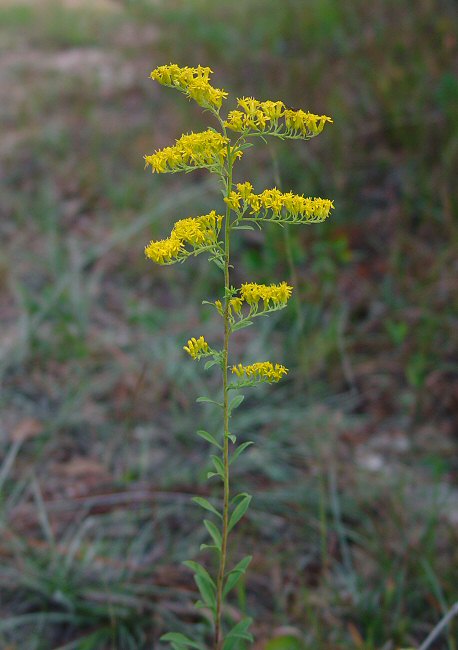Solidago nemoralis Aiton
Old-Field Goldenrod

Native
CC = 2
CW = 5
MOC = 81
© DETenaglia
Solidago nemoralis AitonOld-Field Goldenrod | |
 |
Native CC = 2 CW = 5 MOC = 81 |
© DETenaglia |
|
Family - Asteraceae/Astereae Habit - Rhizomatous perennial forb. Stems - Ascending to erect, usually multiple, to 1 m, with several fine, longitudinal ridges or grooves, densely pubescent with minute, mostly curved hairs 0.1-0.3 mm long, the upper nodes sometimes producing small clusters of leaves in the axils of the main leaves.
Leaves - Leaves basally disposed and persistent at flowering with additional rosettes usually nearby. Basal and lowermost stem leaves with the blade 2-10 cm long, 0.7-2.0 cm wide, mostly 3-8 times as long as wide, nearly linear to narrowly oblanceolate, oblanceolate, or narrowly obovate, tapered gradually to a short to long, winged petiole at the base, rounded or angled to a bluntly or sharply pointed tip, the margins entire or toothed, the surfaces densely pubescent with minute, mostly curved hairs 0.1-0.3 mm long, the undersurface usually with 1 main vein, the fine, pinnate secondary veins usually easily observed. Median and upper stem leaves 0.8-6.0 cm long, linear to narrowly oblanceolate or lanceolate, the margins mostly entire, otherwise similar to the lower stem leaves.
Inflorescences - Dense, often narrowly pyramidal panicles, the longer branches and tip usually somewhat arched or nodding, the heads oriented upward along the branches. Heads - Involucre 3-6 mm long, the bracts in 3-5 unequal series. Involucral bracts oblong-ovate to narrowly oblong-lanceolate and mostly rounded to bluntly pointed at the appressed-ascending tip, the margins hairy (at least toward the tip), the outer surface glabrous. Receptacle naked.
Florets - Ray florets 5-9, the corollas 3.0-5.5 mm long, yellow. Disc florets 3-9, the corollas 2.5-4.5 mm long, the lobes 0.5-0.9 mm long, yellow. Pappus 2-4 mm long, a few of the bristles often slightly thickened toward the tip.
Fruits - Achenes 0.5-2.0 mm long, narrowly obovoid, sparsely to moderately finely hairy. Flowering - July - November. Habitat - Prairies, savannas, glades, bluffs, forest openings, old fields, pastures, railroads, roadsides, and open, disturbed areas. Origin - Native to U.S. Other info. - This species can be found throughout Missouri, and across all but the western third of the continental U.S. The plant can be identified by the grayish color (canescence) of its leaves, which have a soft, yet scratchy feel to them. The leaves also tend to be widest above their midpoints, a feature which is easily discerned with a little practice. S. nemoralis is a characteristic plant of old fields and open grasslands. Photographs taken off Lee Rd 10, Lee County, AL., 10-2-04 (DETenaglia). |